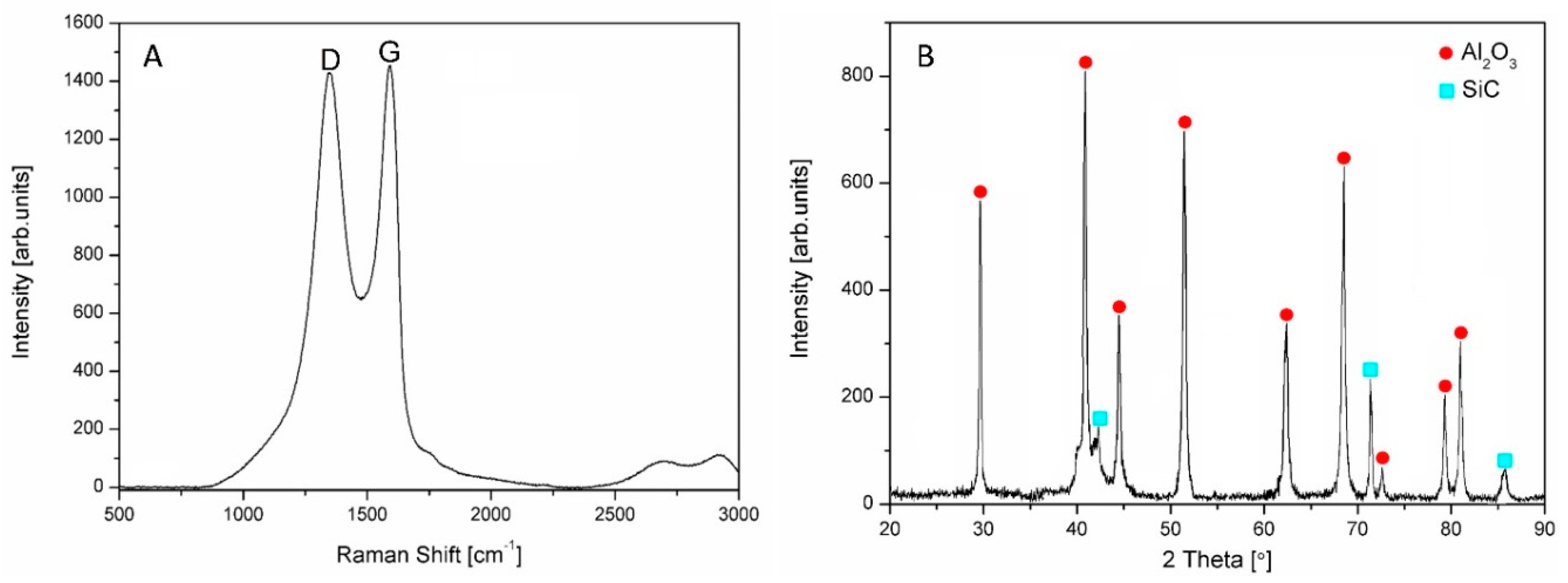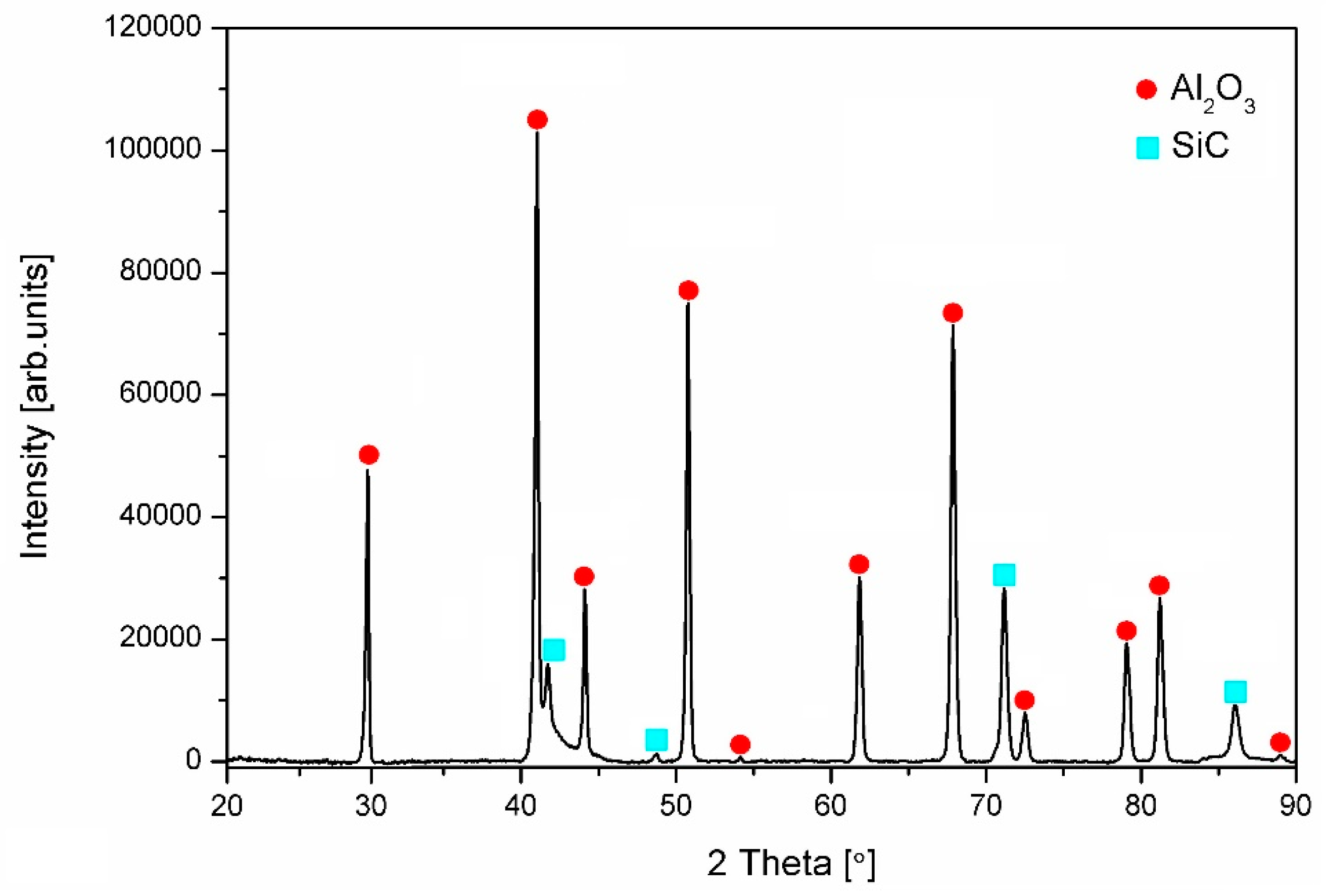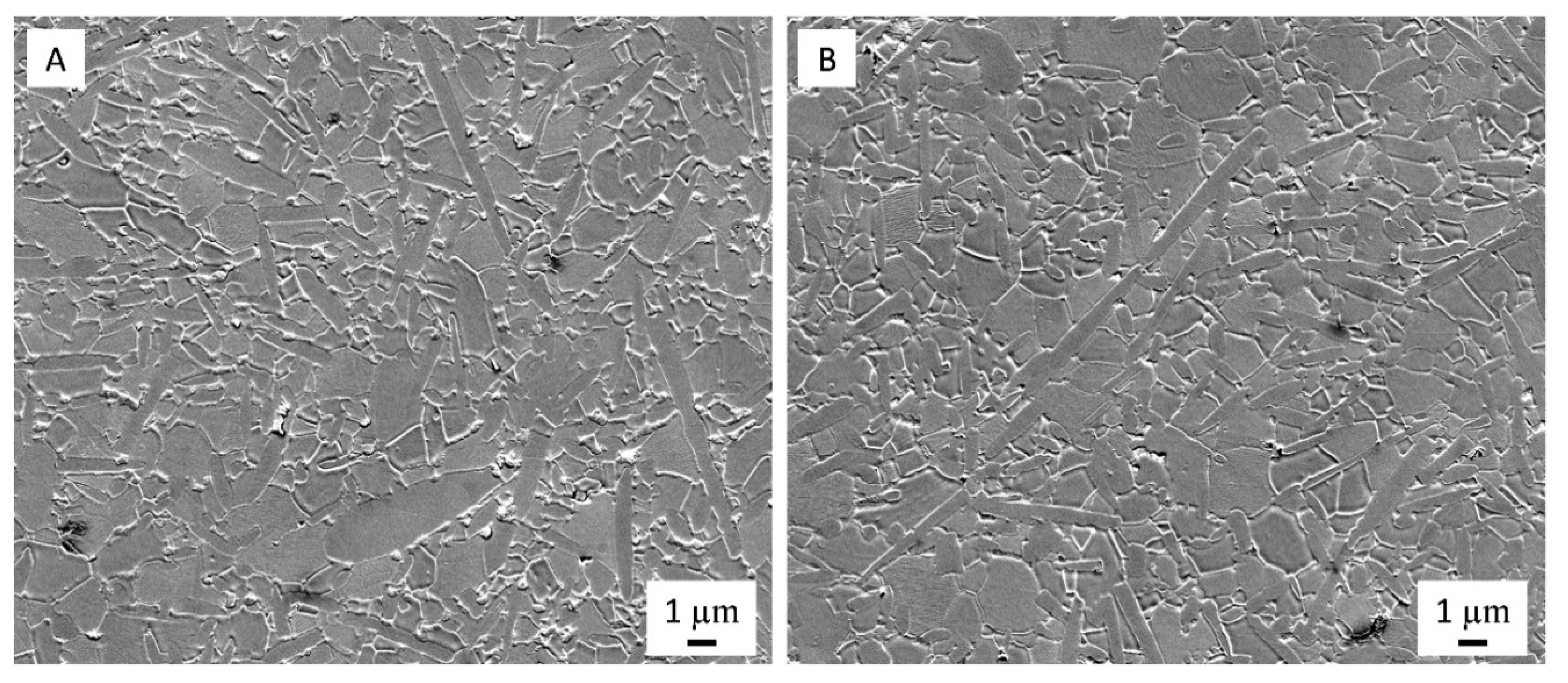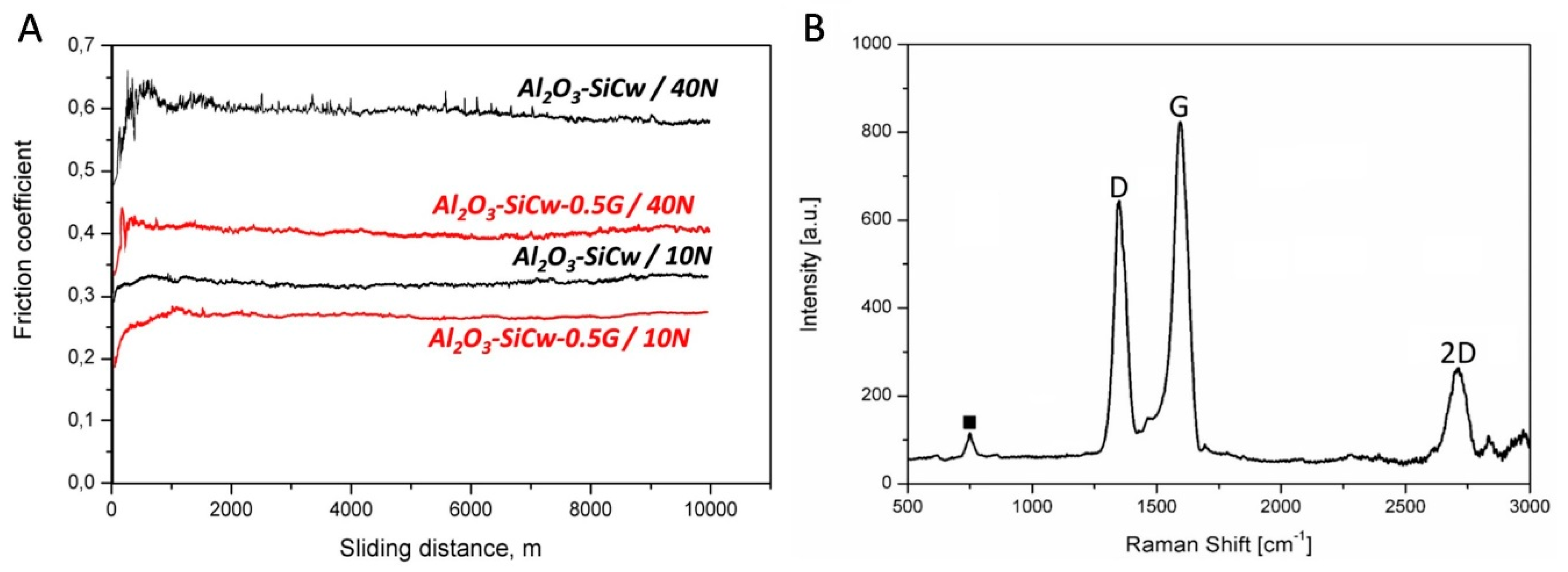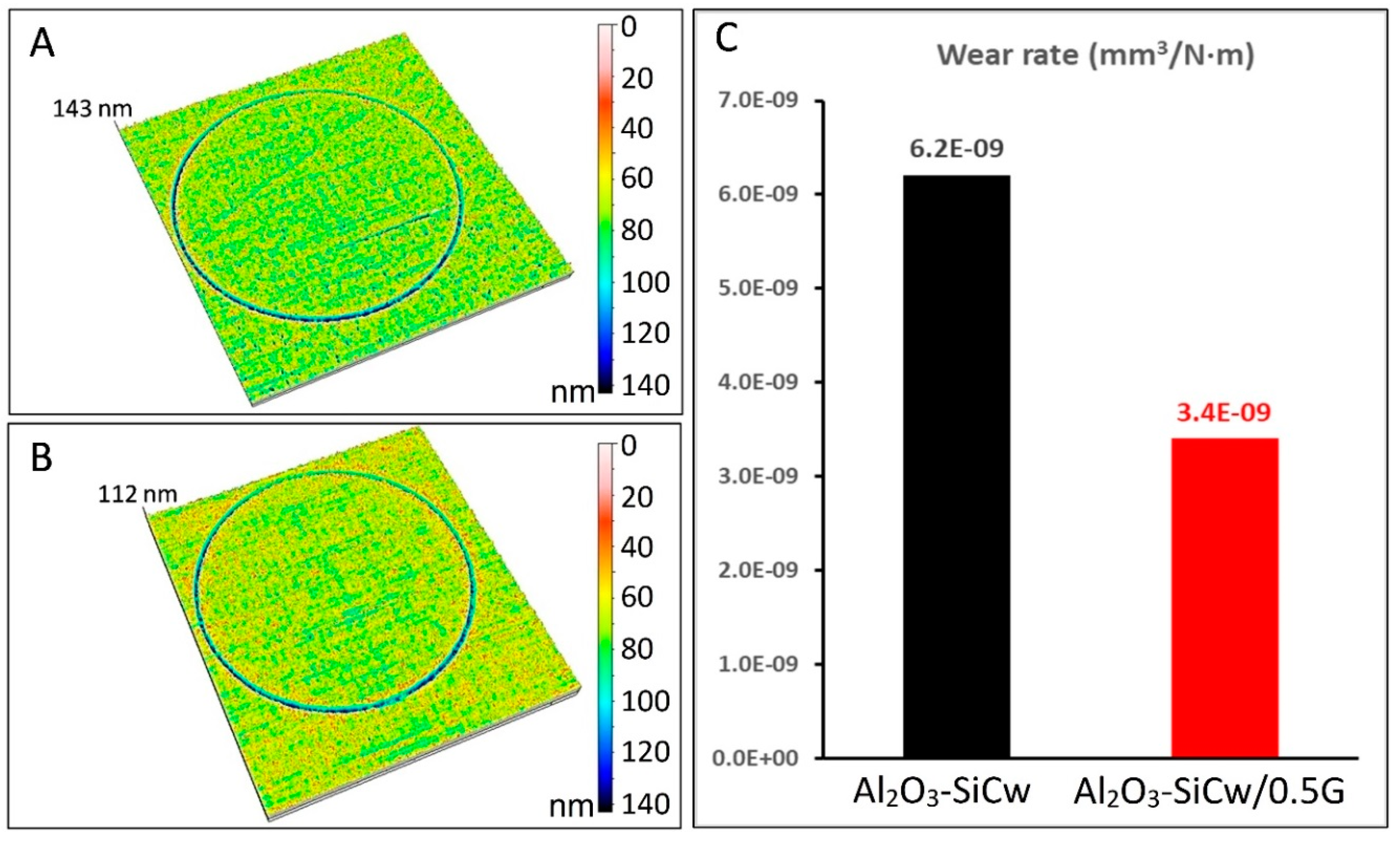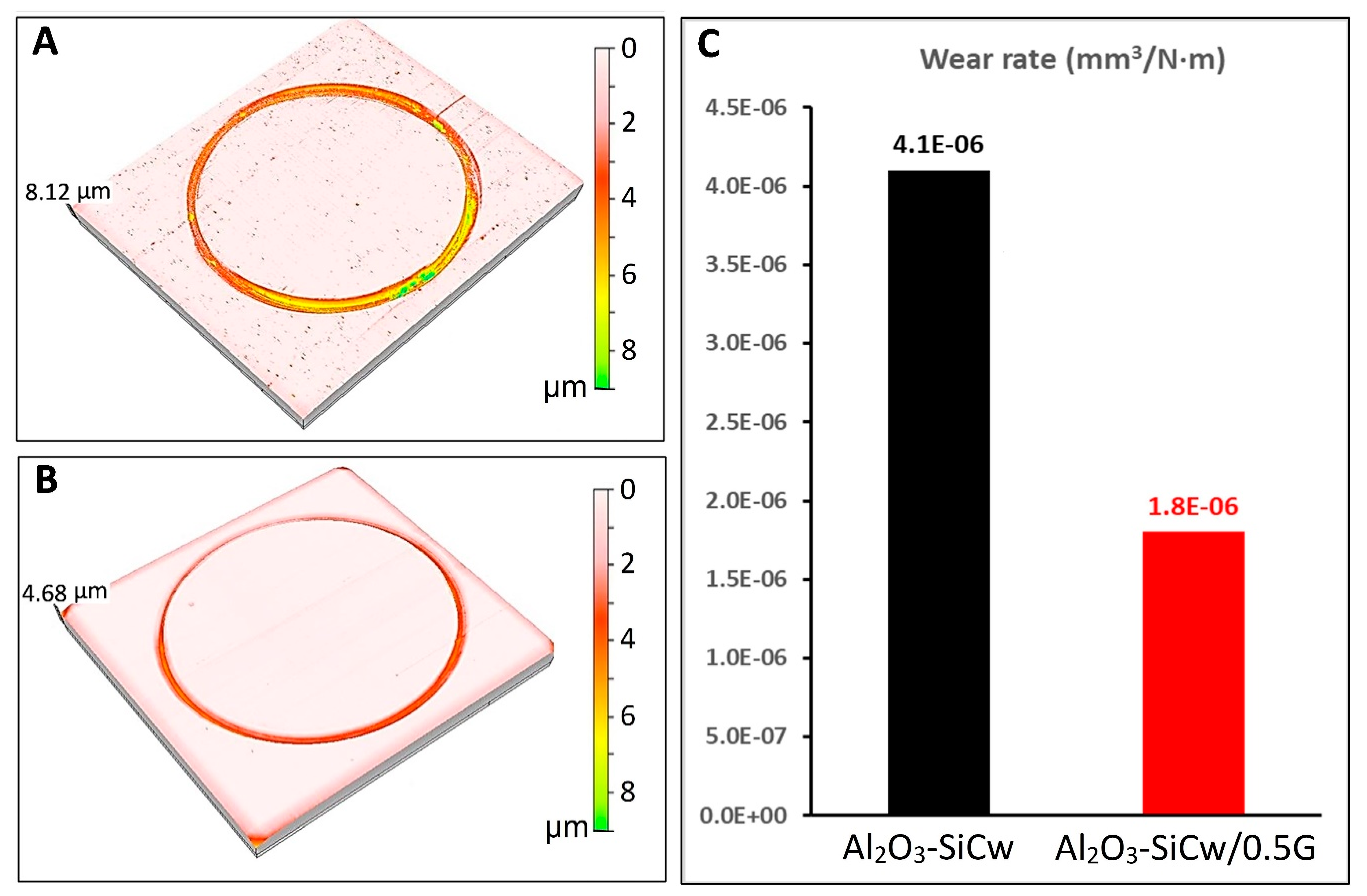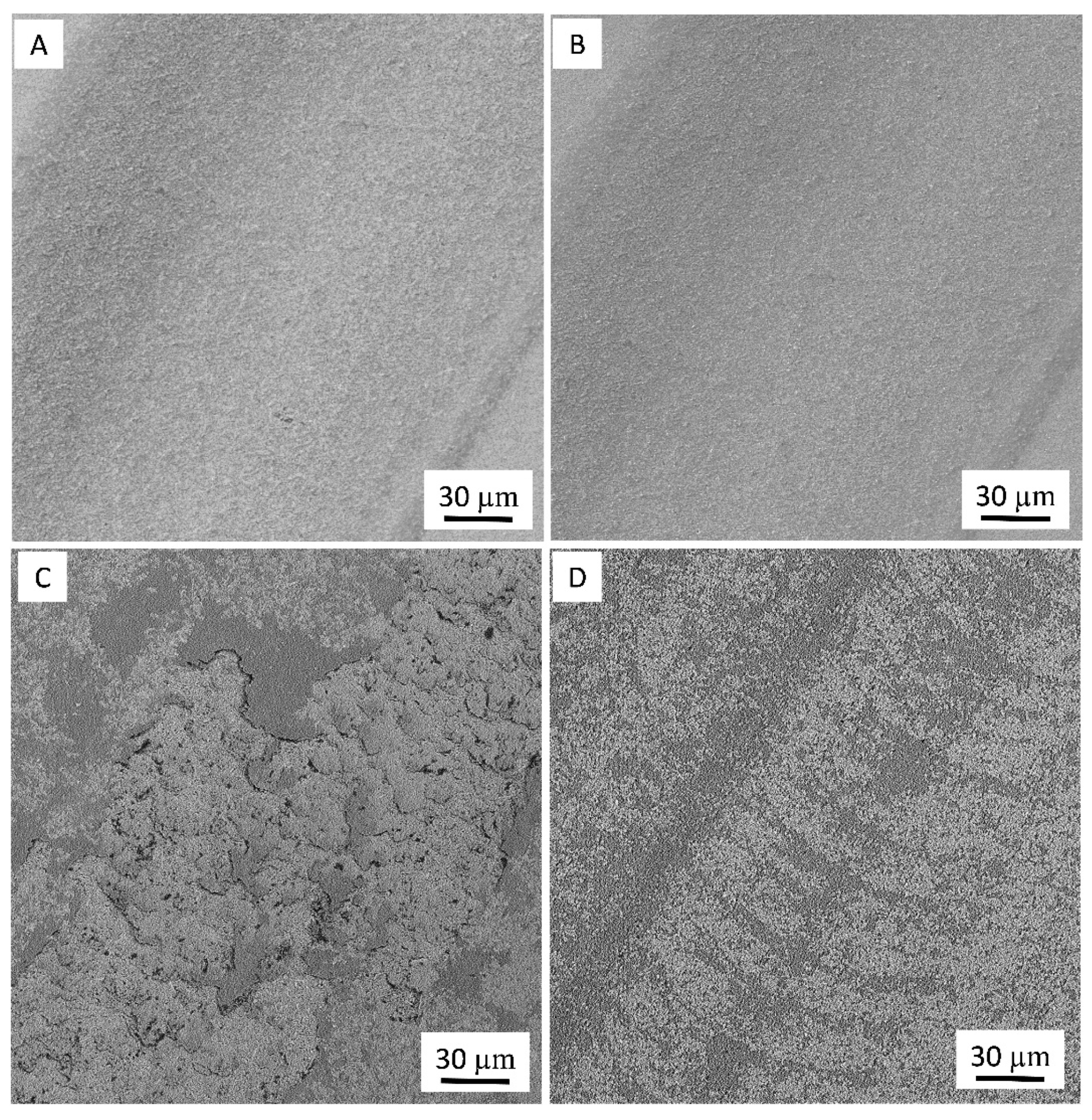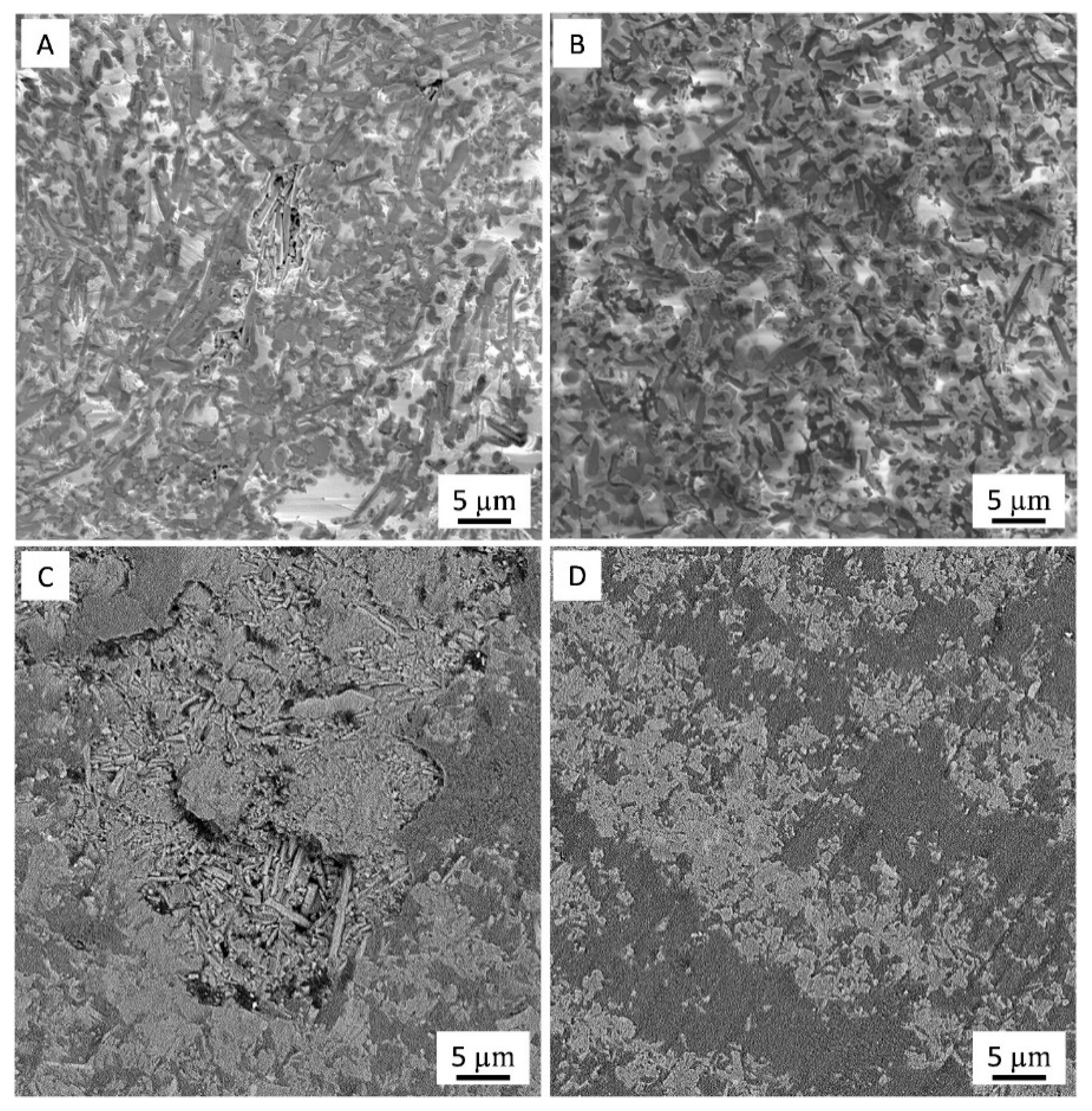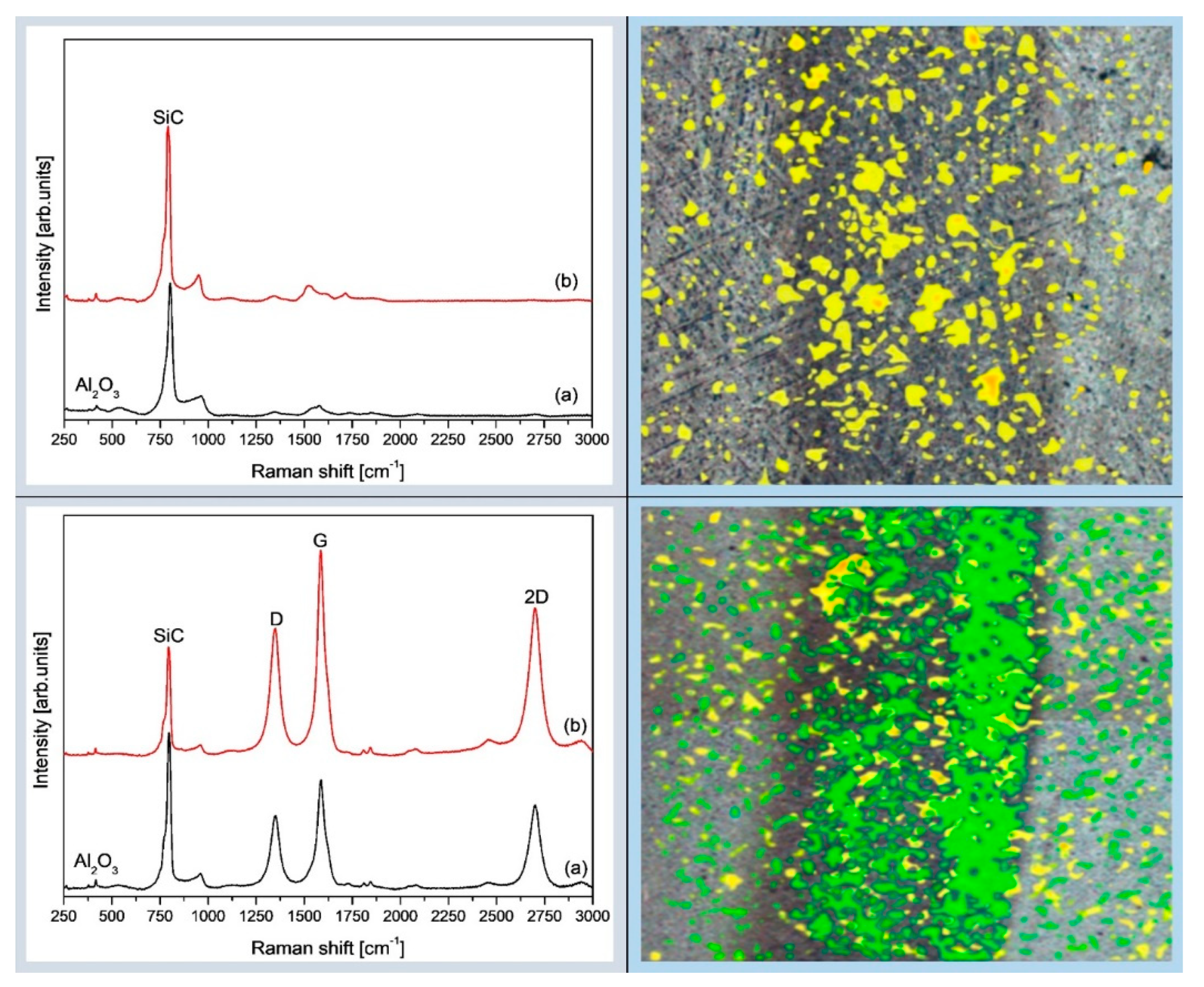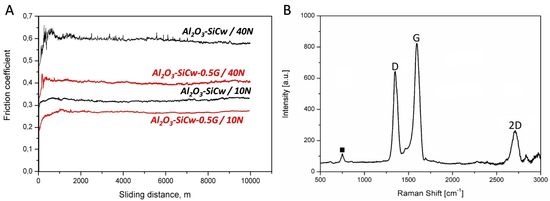1. Introduction
Alumina ceramics with their high hardness, chemical inertness, high wear, and corrosion resistance play an important role in different areas. Nevertheless, moderate strength, toughness, and flaw-tolerance of alumina limit their applications. Thereby, the presence of any type of bulk discontinuities or tiny defects may reduce their reliability [
1,
2]. In order to overcome this limitation, several options have been proposed, for example, the incorporation of SiC whiskers. The primary toughening mechanisms of SiC whisker reinforced alumina ceramics combine crack bridging, fiber pullout, and crack deflection processes. Besides enhancement of mechanical performance, the addition of SiC whiskers also improves wear resistance compared with pure alumina, particularly in the severe wear range, due to the inhibition of crack propagation by the whiskers [
3].
In our previous work [
4], graphene-reinforced Al
2O
3-SiCw ceramic nanocomposites and the influence of the volume fraction of graphene oxide loading on the resulting mechanical and electrical properties were studied. It was found that the ceramic matrix with homogeneous dispersion of a small amount (0.5 vol. %) of graphene is more prone to produce various extrinsic reinforcement mechanisms (crack deflection, pull-out, and bridging), which are promoted due to the presence of graphene at the Al
2O
3-SiCw boundaries. According to the mechanical characterization, Al
2O
3-SiCw/Graphene nanocomposites have the highest flexural strength (904 MPa), fracture toughness (10.6 MPa∙m
1/2), and hardness (22 GPa) in comparison with Al
2O
3/SiCw composites without graphene (750 MPa, 9.5 MPa∙m
1/2 and 21.1 GPa, respectively).
In addition, graphene has a friction-reducing potential for solid lubricating and can decrease the friction force acting on the contact surfaces at the micro- and nano-scale [
5,
6].
Recent studies report on the enhancement of wear performance of ceramic-based nanocomposites in case graphene is added. Kim et al. studied wear and mechanical behavior of pressureless sintered Al
2O
3/Graphene nanocomposites. They found that the exfoliated graphene platelets were effective in enhancing both mechanical and wear resistance properties due to the lack of defects [
7]. For spark plasma sintered SiC/Graphene nanocomposites, Llorente et al. reported an enhanced wear resistance SiC ceramics under dry sliding conditions due to the ability to form a wear protecting graphene-based tribolayer. However, the friction performance depended on the different kinds and amounts of graphene and sliding distance as well [
8]. Rutkowski et al. observed that the friction coefficient decreased from 0.8 to 0.5 if 0.5 wt. % graphene was added to the Si
3N
4 matrix. A graphene content of more than 2 wt. % increases the material wear rates, which can be a result of the graphene removing process and filling the voids by the wearing off of fine silicon nitride particles on the track after the friction test [
9]. Gutierrez-Gonzalez et al. found out that under the same testing conditions the alumina/graphene nanocomposites with an addition of 0.22 wt.% showed approximately half of the wear rate, and a 10% decrease of friction coefficient compared to the monolithic alumina. Decreasing in wear rate and friction coefficient was explained in terms of the presence of graphene platelets that act as a self-lubricating layer on the rubbing surface in comparison to the Al
2O
3/Al
2O
3 tribological system [
10].
The aim of the current study is to investigate the wear behavior of Al2O3-SiCw nanocomposite with 0.5 vol. % graphene addition using dry ball-on-disk wear test under two (10 N and 40 N) sliding loads. The light load can be used to diagnose the onset of wear in the nano/micro-device industry, while higher load is important to study the friction and wear behavior of these nanocomposites for heavy applications (e.g., high temperature valve system, bearing, conveyor system, valves, etc.) and protective coating applications (e.g., armor, prostheses, etc.).
3. Results and Discussion
The Raman spectrum of the as-received graphene oxide and X-ray diffraction pattern corresponding to the as-received Al
2O
3-SiCw powder are presented in
Figure 1. For graphene oxide, typical D and G peaks were observed at ~1350 cm
−1 and ~1605 cm
−1, respectively (
Figure 1A). The D band confirms the lattice distortion due to the disorder in the sp
2 structure whereas G band indicates the graphitic nature.
XRD pattern of the ceramic raw powder shows small broadening of peaks (
Figure 1B), while after sintering peaks are narrower due to crystallization process (
Figure 2).
In addition, the pattern reveals that no contamination and/or presence of side reactions along the sintering of the powder was detected. The peaks corresponding to the graphene structure are not detectable by XRD due to the low content of graphene.
The thermally etched, polished sections of dense Al
2O
3-SiCw (A) and Al
2O
3-SiCw/Graphene (B) sintered composites where the SiCw grains are the elongated inclusions, which were studied by SEM (
Figure 3).
The alumina matrix in both materials exhibits a relatively broad grain size distribution but the mean particle size was similar (around 2 µm).
Figure 4A shows the friction coefficient as a function of the sliding distance registered during the wear test for the Al
2O
3-SiCw ceramic with and without graphene under dry conditions when worn against the alumina ball.
Under a load of 10 N, the friction coefficient for ceramic composites without and with graphene remains stable around 0.31 and 0.25, respectively. When the load was increased to 40 N the friction coefficient for Al
2O
3-SiCw ceramic increased up to 0.65 during the first meters of the experiment, and after this initial stage, the friction coefficient fixed on a steady level (≈0.58). This behavior can be attributed to a polishing process during the wear test where the surface asperities or roughness peaks are removed [
11,
12,
13,
14]. Meanwhile, in the case of the nanocomposite with graphene, the friction coefficient remains stable at 0.41. For ceramic/graphene nanocomposites, the low coefficient of friction can be attributed to the presence of the graphene flakes and the role that they play in the tribological system. It has been published elsewhere that graphene plays an important role in the rubbing behavior due to its lubricant nature that may reduce friction in the sliding interfaces [
15,
16]. Raman spectroscopy studies confirmed the presence of graphene or graphitic phases transferred from the nanocomposite to the worn surface of the alumina ball, and, consequently, the formation of the lubricating layer (
Figure 4B).
Figure 5 and
Figure 6 show the surface topography of the three-dimensional wear tracks and the wear rates for the ceramic and ceramic/graphene materials studied after sliding under 10 N and 40 N load against pure alumina ball, respectively.
In both cases under identical conditions, the deepest wear track was measured for the Al
2O
3-SiCw composite. From the 3D wear track surface topographies, the wear volume loss (
W) was estimated using Equation (1). The favorable effect of the presence of graphene in the ceramic matrix on the wear resistance of the nanocomposites is shown in
Figure 5C and
Figure 6C. The Al
2O
3-SiCw/Graphene nanocomposites under the two loads of 10 N and 40 N is almost double wear resistant compared to that of a matrix material. SEM analysis of the worn surfaces confirmed that the observed changes in wear rate and friction coefficient were due to a fundamental change in the process of wear. At low magnification, morphologies of wear track of both materials when applying the load of 10 N are smooth and look similar (
Figure 7A,B).
However, at high magnification the image of the wear track (Ra ~ 0.076 µm) of Al
2O
3-SiCw ceramic (
Figure 8A) shows evidence of pull-out, while the wear scar of the Al
2O
3-SiCw/Graphene nanocomposite exhibits a smooth wear surface (Ra ~ 0.049 µm) as shown in
Figure 8B.
On the other side, it is clear that the morphology of the wear tracks for both composites is different at a higher applied load (40 N) from a lower applied load (10 N), even at low magnification (
Figure 7C,D). Additionally, it should be noted that obtained was a set of images that were similar and, therefore, we considered them as sufficiently representative.
Under high load, the texture of the wear surface consists of the repeated strips perpendicular to the sliding direction was observed. In addition, in a material with graphene, the friction surface presents periodic dark (2–5 μm width) and light (10–30 μm width) curve shape strips perpendicular to the sliding direction likely radius of the counterbody (
Figure 7D).
As shown in
Figure 8C, the composite without graphene worn surface generated under the high load was generally rough (Ra ~ 0.142 µm). Under these conditions, the pulled-out grains were observed, and the dominant material removal mechanism was determined as an intragranular fracture (
Figure 8C). Meanwhile, for the nanocomposite with graphene under the same sliding conditions, a relatively smooth surface (Ra ~ 0.087 µm) was observed (
Figure 8D).
The addition of graphene to the ceramic matrix significantly improve the wear resistance of the nanocomposites under high load due to less alumina and SiCw grain pull-out during the wear test. The reason for this behavior might be due to the presence of an auto-lubricating layer of graphene in the ceramic matrix that provides sufficient lubrication between the specimen and the alumina ball that acts as a counterpart material. Moreover, a higher fracture toughness and less tangential force applied to the alumina grains in nanocomposites with graphene contribute to the decrease in crack propagation during the test in comparison to the composites without graphene [
4].
In order to study the role played by graphene in the wear process, wear tracks and debris were studied by micro-Raman spectroscopy (
Figure 9).
Besides peaks like alumina at ~ 420 cm−1, silicon carbide at ~ 799 cm−1, the three typical peaks corresponding to the graphene-based structure at ∼ 1350 cm−1 (D band), ∼ 1585 cm−1 (G band) and ∼ 2700 cm−1 (2D band) were detected.
Figure 9 (left column) shows the comparison of the Raman spectra of the untested and worn surface of the composites without and with graphene addition. The intensity of the Al
2O
3 and SiC peaks inside and outside of the wear track of Al
2O
3-SiCw composites is similar, while inside the wear track of Al
2O
3-SiCw/Graphene nanocomposites, the scans revealed an increase in the D peak intensity. Thus, the increased D peak intensity inside the wear track of the Al
2O
3-SiCw/Graphene nanocomposite confirmed the higher percentage of the graphene surface exposed to the Raman measurement in the damaged surface and tribolayer formation during tribology testing on the Al
2O
3-SiCw/Graphene nanocomposites resulting in improved wear properties.
By merging both spectra, in particular, the SiC and graphene-based structures bands, and SEM photos of the analyzed area of the Al
2O
3-SiCw (top) and Al
2O
3-SiCw/Graphene (bottom) composites colored debris maps were created (
Figure 9 right column). Green and yellow colored zones of the Raman maps of the composites show the presence of the D- and G-peaks and SiC peaks, respectively. As can be seen the whole damaged surface of the nanocomposite with graphene is green only with the small presence of SiC, which can provide experimental evidence of the graphene enriched layer caused by the sliding force and consequently self-organization phenomenon. Additionally, the periodic dark and light curve shape strips observed on the friction surface (
Figure 7D) might be viewed as a trace of a self-organization response to the wear process; our group has discussed this view in detail elsewhere [
17,
18,
19].
In summary, the present work demonstrates that the Al
2O
3-SiCw/Graphene nanocomposites show a lower friction coefficient and a higher wear resistance, related to the presence of an adhered tribolayer of graphene platelets on the worn surface of the alumina ball and composite that enhances the tribological performance of ceramic/graphene composites. Evidence for the formation of such tribofilm includes Raman spectroscopy mapping and SEM (
Figure 9).
